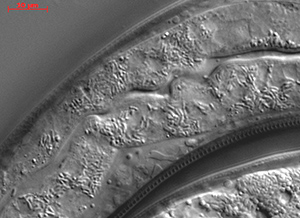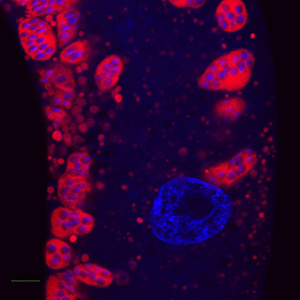Discovery of Microbe in Roundworm Provides Animal Model for 'Emerging Pathogen'
December 8, 2008
By Kim McDonald
An international team of biologists has discovered a new species of microsporidia, a single-celled parasite of animals, in a roundworm used in genetic laboratories around the world.
The discovery, detailed in the current issue of the journal PLoS Biology, is a breakthrough for public health researchers who until now had been looking for a suitable laboratory model in which to study microsporidia-a class of emerging pathogens that can cause significant illness in humans.

Roundworm intestine infected with microsporidia spores
Credit: Emily Troemel, UCSD
"Microsporidia are classified as 'priority pathogens' by the National Institutes of Health, since they have been found in water supplies and because no drugs are available for treating the most common infections they cause in humans," said Emily Troemel, an assistant professor of biology at UC San Diego and the first author of the study. "The new species we discovered, which infects the nematode C. elegans, a small roundworm that is very easy to study in the lab, provides a powerful system in which to study these mysterious microbes, learn how these animals respond to infection and develop new drugs to fight infections of microsporidia."
"The discovery of this new microsporidian that infects nematodes is particularly exciting because it potentially offers a unique opportunity to identify new drugs for treating human microsporidian infections," said Frederick Ausubel, a professor of genetics at the Harvard Medical School who headed the research collaboration.
The researchers named their new species of microsporidia Nematocida parisii, or "nematode killer from Paris," because it was initially discovered in the intestines of roundworms found in Parisian compost pits. Since then, the scientists have found close relatives living in the wild in Portugal and India, leading them to conclude that they are widespread natural parasites of C. elegans.
Microsporidia infections in humans, known as Microsporidiosis, are primarily found in patients with compromised immune systems, such as those infected with HIV or who have undergone organ transplants. Of the more than 1,200 known species of microsporidia-which were initially thought to be protozoans, but are now classified as single-celled fungi-only 15 species are known to infect humans through contaminated water or food.
Because the newly discovered species of microsporidia infects the intestines of roundworms in the same way as other species of microsporidia infect human intestines and because the bodies of C. elegans are transparent, infections of this new species in C. elegans provide an especially useful laboratory model to learn how this class of microbes infect humans and can be treated with drugs.

Roundworm intestine stained to reveal microsporidia cytoplasm in red and their DNA in blue.
Credit: Emily Troemel, UCSD
" C. elegans has intestinal cells that look almost exactly like human intestinal cells, so we're able to tell what these parasites are doing to intestinal cells as they're invading and exiting the cells," said Troemel. "And because these worms are completely transparent, we can take intact worms, put them on a slide and see what's happening to their intestinal cells. We've already seen some interesting changes in the structure of those intestinal cells during the different time periods of the infection."
The discovery of Nematocida parisii initially occurred when two biologists at the Institut Jacques Monod in Paris, Marie-Anne Félix and Antoine Barrière, found a parasite in a population of C. elegans living in a compost pit with rotting fruit.
" C. elegans has been a 'lab rat' for scientists for decades and little is known about what it encounters in its natural environment, so this group had been trying to find out more about its natural habitat," said Troemel.
The French researchers sent the wild-caught infected nematodes to Troemel, then a postdoctoral fellow working in Ausubel's Harvard Medical School laboratory, to determine the nature of the pathogen.
"We originally thought they were bacteria, because they looked very similar to bacteria," said Troemel, who used a series of genetic tests and phylogenetic analyses to reveal the parasite's true identity. "But it turned out to be not only a new species of microsporidia, but a new genus of microsporidia."
The research project was supported by grants from the National Institutes of Health and the French Research Ministry and Leukemia/Lymphoma Society.
Related Links